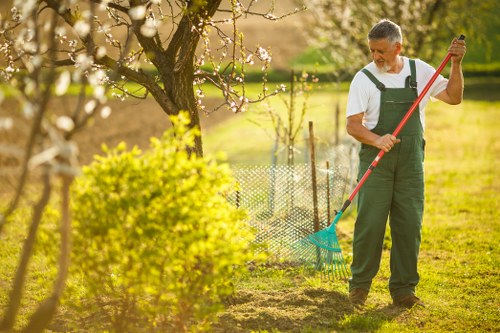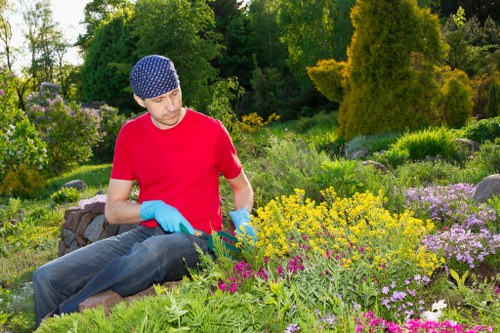Grass Cutting in Hackney Marshes

Importance of Regular Grass Cutting
Maintaining the lush greenery of Hackney Marshes is essential for both the ecosystem and the community. Regular grass cutting ensures that the marshes remain a safe and enjoyable space for all visitors.
Proper grass maintenance helps in preventing the overgrowth of unwanted weeds, which can disrupt the natural habitat of various plant and animal species. It also plays a crucial role in reducing the risk of wildfires during dry seasons.
Moreover, well-maintained grass areas enhance the aesthetic appeal of Hackney Marshes, making it a more pleasant environment for recreational activities such as walking, jogging, and picnicking.

Techniques for Efficient Grass Cutting
Choosing the Right Equipment
Selecting appropriate grass-cutting machinery is vital for effective maintenance. Mowers should be powerful enough to handle the dense grass typical of marshlands without causing damage to the soil structure.
Electric mowers are environmentally friendly options that reduce noise pollution, which can disturb local wildlife. Additionally, regular maintenance of equipment ensures longevity and consistent performance.
For larger areas, ride-on mowers may be more efficient, allowing for quicker coverage and reducing the physical strain on maintenance workers.
Optimal Cutting Schedules
Establishing a regular grass-cutting schedule helps maintain uniformity and prevents overgrowth. Seasonal adjustments to the schedule may be necessary to accommodate varying growth rates throughout the year.
During peak growth periods in spring and summer, more frequent mowing might be required, whereas in autumn and winter, the grass growth may slow down, reducing the need for constant maintenance.
Consistency in mowing schedules also aids in monitoring the health of the grass, allowing for early detection of diseases or pest infestations.

Environmental Considerations
Sustainable Practices
Implementing sustainable grass-cutting practices minimizes the environmental impact on Hackney Marshes. Using battery-powered or manual tools reduces carbon emissions and promotes a healthier ecosystem.
Mulching the grass clippings instead of removing them can return valuable nutrients to the soil, enhancing its fertility and promoting robust plant growth.
Integrating eco-friendly practices ensures that the marshes remain a vibrant habitat for wildlife while providing a beautiful space for the community.
Wildlife Protection
Grass cutting should be conducted with care to protect the diverse wildlife that inhabits Hackney Marshes. Early morning or late evening mowing can minimize disruption to animal activity.
Identifying and preserving nesting sites and habitats for birds, insects, and small mammals is crucial. Avoiding cutting areas near water bodies helps maintain the natural balance and supports aquatic life.
Educating maintenance staff on the importance of wildlife conservation fosters a more harmonious relationship between man and nature in the marshlands.

Community Involvement
Volunteer Programs
Engaging the local community through volunteer grass-cutting programs fosters a sense of ownership and responsibility towards Hackney Marshes. Volunteers can assist in maintaining trails, open spaces, and areas of high foot traffic.
Organizing regular community events not only aids in grass maintenance but also strengthens community bonds and promotes environmental stewardship.
Providing training and resources to volunteers ensures that grass-cutting efforts are effective and aligned with best practices for marshland conservation.
Educational Initiatives
Educational programs about the importance of grass cutting and marshland preservation can inspire residents to participate actively in maintenance efforts. Schools and local organizations can collaborate to integrate these topics into their curricula and activities.
Workshops and informational sessions provide valuable knowledge on sustainable practices and the ecological significance of Hackney Marshes, encouraging informed participation.
Raising awareness about the benefits of well-maintained grass areas promotes a collective effort in preserving the natural beauty and functionality of the marshlands.

Challenges and Solutions
Weather Conditions
Unpredictable weather patterns can pose challenges to regular grass cutting in Hackney Marshes. Heavy rains may lead to muddy conditions, while droughts can cause grass to become brittle and prone to damage.
Developing flexible maintenance schedules that adapt to weather changes ensures consistent care without compromising the health of the marshlands.
Implementing drainage solutions and selecting drought-resistant grass species can mitigate the adverse effects of extreme weather conditions.
Resource Management
Efficient allocation of resources, including manpower and equipment, is crucial for effective grass cutting. Prioritizing high-traffic areas and vulnerable sections of the marshes ensures that maintenance efforts are optimized.
Investing in durable and efficient equipment reduces long-term costs and enhances the overall quality of grass maintenance.
Collaboration with local authorities and organizations can provide additional support and resources, addressing budgetary and logistical challenges.
Nearby Areas to Hackney Marshes
- Victoria Park: Located just north of Hackney Marshes, Victoria Park offers expansive green spaces and recreational facilities.
- Regent's Canal: To the west, this scenic waterway provides walking paths and picturesque views, complementing the marshlands.
- Colegate: A nearby residential area benefiting from the proximity to Hackney Marshes' open spaces for leisure activities.
- South Hackney South of the marshes, this area features community centers and local markets, enhancing the neighborhood's vibrancy.
- Bruce Grove: Adjacent to Hackney Marshes, Bruce Grove is known for its cultural diversity and close-knit community.
- Landlord’s Gardens: East of the marshes, these gardens offer serene environments for relaxation and small gatherings.
- Highbury Northwest of Hackney Marshes, Highbury boasts historical sites and well-kept parks that complement the marshlands.
- Bethnal Green A short distance from the marshes, this area combines urban living with easy access to green spaces.
- Clissold Park: Southwest of Hackney Marshes, Clissold Park provides a blend of recreational areas and wildlife habitats.
- Shoreditch Although more urban, Shoreditch's proximity to the marshes allows residents to enjoy both city life and natural retreats.
- Hackney Central: Directly adjacent, Hackney Central benefits from the recreational opportunities provided by the marshes.
- Dalston To the northwest, Dalston offers vibrant nightlife and benefits from the nearby green spaces for relaxation.
- Tipton Green: A neighboring area that shares the same commitment to maintaining the beauty and ecology of Hackney Marshes.
- London Fields: While slightly further, London Fields' proximity allows residents to easily access the extensive grass-cutting efforts in Hackney Marshes.
Frequently Asked Questions
1. How often is the grass cut at Hackney Marshes?
Grass cutting at Hackney Marshes typically occurs on a bi-weekly basis during the growing season, with adjustments made based on weather conditions and grass growth rates.
2. Are there any volunteer opportunities for grass cutting?
Yes, Hackney Marshes encourages community involvement through volunteer programs. Interested individuals can contact the local maintenance team to participate in scheduled grass-cutting events.
3. What types of grass are maintained in Hackney Marshes?
The marshes primarily feature native grass species such as perennial ryegrass and fescues, which are well-suited to the local climate and soil conditions.
4. How does grass cutting benefit the local wildlife?
Regular grass cutting maintains a balanced ecosystem by preventing overgrowth that can disrupt habitats. It ensures that wildlife has access to necessary resources while preserving the diversity of plant species.
5. Can I request grass cutting in specific areas of Hackney Marshes?
Yes, community members can reach out to the maintenance team with specific requests or concerns regarding grass cutting in particular sections of the marshes to ensure targeted and effective maintenance.

